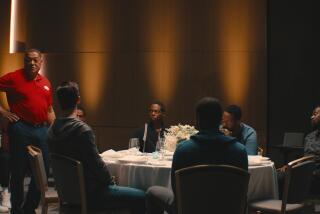A timeline on the Donald Sterling saga

The $2-billion sale of the Los Angeles Clippers to former Microsoft CEO Steve Ballmer was finalized Tuesday.
- Share via
Tuesday’s news that Steve Ballmer’s record $2-billion bid to purchase the Clippers became official is just the latest development in the saga the started in April. What began with a recording of Donald Sterling and a female companion last fall spiraled into a public spectacle that NBA Commissioner Adam Silver called an “unprecedented” crisis for the league. It ended — maybe — with the sale of the franchise that Donald Sterling previously insisted he’d never surrender.
Sept. 12, 2013: V. Stiviano uses her iPhone to record a heated discussion with Donald Sterling at her home in which he makes inflammatory comments about African Americans.
April 9: Stiviano texts the recording to an unnamed Clippers employee. One of Stiviano’s text messages in the exchange reads, “Let the games began [sic].” Team President Andy Roeser is notified of the recording and informs Sterling.
Between April 9-25: After Roeser discusses the matter with Sterling, Roeser requests the employee erase the recording and associated text messages from their phone, according to the NBA investigation.
April 23: A TMZ reporter contacts the Clippers for comment about the Sterling recording.
April 24: Clippers chief spokesman Seth Burton suggests Roeser contact the NBA about the recording, the NBA investigation claimed. Roeser is said not to contact the league.
April 25: TMZ publishes the tape late in the day.
April 26: A Clippers employee told tells the investigator retained by the NBA that the employee spent much of the day in a San Francisco hotel room with Donald and Shelly Sterling. Both take an active role in “reviewing and revising” a statement released later that day questioning the recording’s veracity.
April 26: Two hours after the statement’s release, the NBA’s investigator interviews Donald Sterling by telephone.
April 26: In response to the recording, Clippers Coach Doc Rivers says, “I think the biggest statement we can make as men — not as black men, as men — is to stick together and show how strong we are as a group, not splinter, not walk.”
April 27: During a news conference in Malaysia, President Obama calls Sterling’s comments on the recording “incredibly offensive.”
April 28: More than a dozen Clippers sponsors suspend or cancel their relationship with the franchise.
April 28: Stiviano is interviewed by the investigator in Los Angeles.
April 28: Through attorney Bob Platt, Donald Sterling declines an in-person interview with the investigator.
April 28: Roeser is interviewed by the investigator at the Clippers’ facility.
April 28: In a telephone interview with the investigator, Shelly Sterling confirms her husband’s voice on the recording.
April 29: NBA Commissioner Adam Silver bans Sterling for life, fines him $2.5 million and announces plans to pursue termination of his ownership.
April 30: In a telephone conversation, Donald Sterling tells Silver that he understood the need for the penalties but that “there’s nothing in the recording that’s bad.”
May 2: Before Stiviano’s interview with ABC’s Barbara Walters, Sterling asks Stiviano to lie to the NBA about the recording and say she altered it, the league’s investigation said.
From May 5-15: Twenty Clippers employees are interviewed in person and by telephone as part of the NBA investigation.
May 6: Roeser, part of the franchise since 1984, is placed on indefinite leave by Silver.
May 8: In a statement, Shelly Sterling says she wants to keep her 50% stake in the Clippers for life, but welcomes a new owner to replace her husband.
May 10: Dick Parsons, former Citigroup and Time Warner chairman, is named interim chief executive of Clippers.
May 11: Shelly Sterling tells ABC’s Walters that she plans to divorce her husband and has no intention of surrendering her stake in the Clippers.
May 12: Donald Sterling apologizes for his recorded comments, but criticizes Magic Johnson and the community involvement of African Americans in a televised interview with CNN’s Anderson Cooper.
May 13: In an interview on the “Today” show, Shelly Sterling says she believes her husband has dementia.
May 15: The Clippers’ season ends with a 104-98 loss to the Oklahoma City Thunder in Game 6 of the Western Conference semifinals.
May 19: The NBA files formal charges against Donald Sterling to start the process to terminate ownership of the team. The franchise is jointly owned by both Sterlings through the Sterling Family Trust; the league’s documents make clear it wants an entirely new ownership group. The league’s report disputes that the Sterlings are “estranged.” A June 3 hearing in New York is set for league owners to vote on termination.
May 19: The NBA rejects a request by Donald Sterling’s attorneys to delay the termination proceedings three months.
May 19: Donald Sterling is examined by Dr. Meril Sue Platzer at his home in Beverly Hills.
May 20: Silver says at a news conference, “We know we’re doing the right thing and I know I have the owners behind me.”
May 22: Donald Sterling signs letter authorizing Shelly Sterling to negotiate sale of Clippers.
May 22: Dr. J. Edward Spar examines Donald Sterling.
May 23: Changing strategy, the Sterlings plan to shift full ownership of the Clippers to Shelly Sterling, who would pursue a sale. Such a move needs the NBA’s approval. In a statement, the NBA says it plans to proceed with the June 3 hearing.
May 27: In a 30-page response to the NBA’s charges, Donald Sterling describes the league’s termination process as “illegal” and says he has offers “in excess of $2.5 billion” for the franchise.
May 28: At least three bids to purchase the Clippers are received by a group fronted by Shelly Sterling, as the first round of bidding closes. She appears to drop her plan to maintain a stake in the team. But in a reversal, Donald Sterling, who previously agreed to let his wife sell the team, says through an attorney that he plans to fight the NBA’s termination effort.
May 29: Steve Ballmer, the former Microsoft CEO, wins the bidding orchestrated by Shelly Sterling. Meanwhile, an attorney for Donald Sterling says he doesn’t believe his client will sell the franchise.
May 30: Donald Sterling sues the NBA for $1 billion in federal court.
June 4: One of Sterling’s attorneys, Bobby Samini, announces Sterling agreed to sell the Clippers to Ballmer and resolve all issues with the NBA.
June 9: Sterling writes letter revoking Sterling Family Trust.
June 9: Sterling leaves angry voice mails for two doctors who declared him mentally incompetent.
June 10: Sterling issues statement calling NBA “discriminatory” and “incompetent.” Finishes statement with: “THIS IS THE REASON I WILL NOT SELL MY TEAM.”
June 11: Shelly Sterling files ex parte petition in Los Angeles Superior Court seeking court’s approval for sale to Ballmer.
July 8: Donald Sterling testifies in court, calls opposing attorney Bert Fields a “smartass” during a series of contentious exchanges.
July 9: Sterling testifies again. Calls Shelly Sterling “you pig” following his time on the stand.
July 22: Sterling files new lawsuit accusing NBA, Silver and Shelly Sterling of fraud.
July 28: Minutes after closing arguments, Judge Michael Levanas rules against Donald Sterling on every substantive issue to clear the way for Ballmer’s purchase.
Aug. 11: NBA files counterclaim against Sterling in federal lawsuit.
Aug. 12: Levanas issues final order; Ballmer completes sale within minutes.
Aug. 12: Donald Sterling petitions an appeals court to overturn Levanas’ ruling that allowed the sale.
Aug. 13: The state’s 2nd Court of Appeals rejects Donald Sterling’s petition to overturn Levanas’ ruling.
More to Read
Get our high school sports newsletter
Prep Rally is devoted to the SoCal high school sports experience, bringing you scores, stories and a behind-the-scenes look at what makes prep sports so popular.
You may occasionally receive promotional content from the Los Angeles Times.







